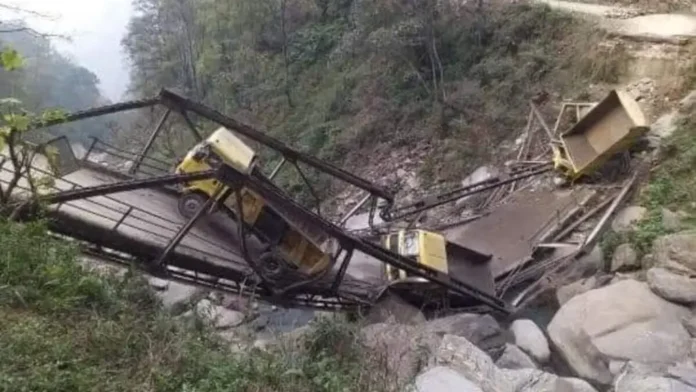The Sikkim Yuksom bridge collapse has disrupted life in West Sikkim after continuous rainfall triggered major landslides on Wednesday night. The destruction of the key bridge near Yuksom town has left multiple villages in the region cut off, sparking emergency response from state authorities.
Located near the entry point to Khangchendzonga National Park, the damaged bridge served as the primary access route for several high-altitude settlements. Following the incident, supply chains, transport, and emergency services have been severely affected.
Read More: Sikkim Glacial Lake Hazard: Centre Completes Full Survey
Heavy Rain Triggers Widespread Landslides
Sikkim has witnessed intense rainfall over the last 72 hours. According to the Indian Meteorological Department (IMD), Yuksom recorded over 180 mm of rainfall in a single day, the highest this monsoon season.
This sudden deluge triggered multiple landslides along the Geyzing-Yuksom road, causing the bridge to collapse into the Rangit River. Local residents reported loud rumbling noises before the structure gave way.
An eyewitness from Yuksom said, “The ground trembled for a few minutes. Then the bridge just fell apart. Thankfully, no one was on it at the time.”
Connectivity Cut for Villages and Pilgrimage Routes
The Sikkim Yuksom bridge collapse has disconnected at least six remote villages, including Sachen, Tshoka, and Dzongri. These areas are home to hundreds of families and serve as key stops for trekkers and pilgrims heading to sacred peaks.
With no alternate road access, locals are currently depending on forest trails and temporary rope bridges. Officials have already sent teams to assess alternative connectivity options, although rough terrain poses a challenge.
Transport of food, medical supplies, and construction material has come to a standstill. Helicopter services may be launched if weather conditions improve.
Authorities Begin Damage Assessment and Relief Work
West Sikkim’s District Collector Tashi Chopel confirmed that no casualties occurred during the incident. However, several homes near the landslide zones have suffered structural cracks, and three families were relocated as a precaution.
The Public Works Department (PWD) has begun debris clearance, and engineers from the Border Roads Organisation (BRO) have arrived at the site. They aim to create a temporary footbridge within 48 hours.
Speaking to media, Chopel said, “We are prioritizing connectivity and safety. Relief material has already been dispatched to affected villages.”
The state disaster management team is coordinating with the army and local volunteers to ensure timely assistance.
Tourists and Pilgrims Advised to Delay Travel
Due to the fragile conditions in Yuksom and surrounding areas, the tourism department has issued an advisory for visitors to postpone treks and religious journeys. Khangchendzonga National Park remains inaccessible until the alternate route is restored.
Tour guides and homestay operators have begun refunding or rescheduling travel plans. This landslide is likely to impact the peak trekking season, which typically begins in mid-July.
Officials have also urged hotels to keep backup power and ration supplies in case of extended disconnection.
Experts Warn of Increased Risk
Geologists have expressed concern over repeated infrastructure failures due to unstable soil and erratic rainfall in the region. Experts suggest that changing glacial patterns and unregulated construction have worsened the risks.
Environmental scientist Dr. Karma Dorjee stated, “The terrain is fragile. Without sustainable planning, events like the Sikkim Yuksom bridge collapse will become more common.”
He further recommended installing rain gauges, slope monitoring systems, and community-based disaster awareness programs.
What Comes Next
The Sikkim government is now preparing a detailed report for the central government, seeking funds for rebuilding the collapsed bridge and reinforcing other vulnerable spots. A long-term plan to climate-proof critical infrastructure is also under discussion.
Immediate steps include:
- Construction of a temporary footbridge within two days
- Deployment of mobile health units in cut-off villages
- Aerial surveys for damage mapping
- Installation of landslide alert systems
Chief Minister Prem Singh Tamang expressed concern and assured residents that restoration efforts would be fast-tracked. “We stand with every affected family. Our priority is safe, permanent solutions,” he said in a social media post.
Read More: Tripura Allocates Three Departments to Cabinet Minister Kishor Barman



